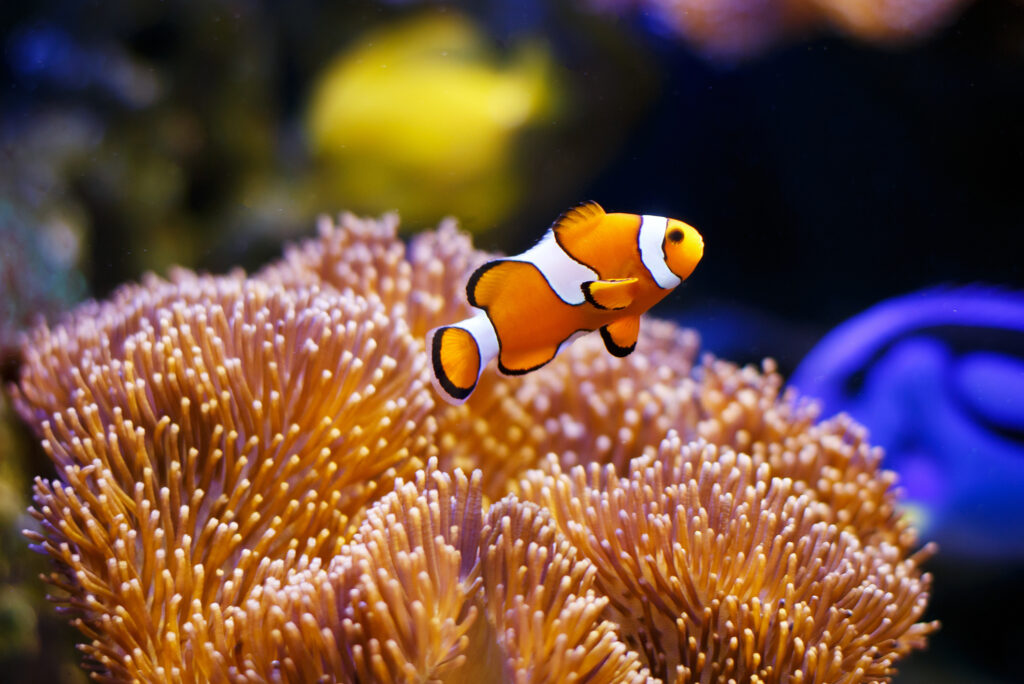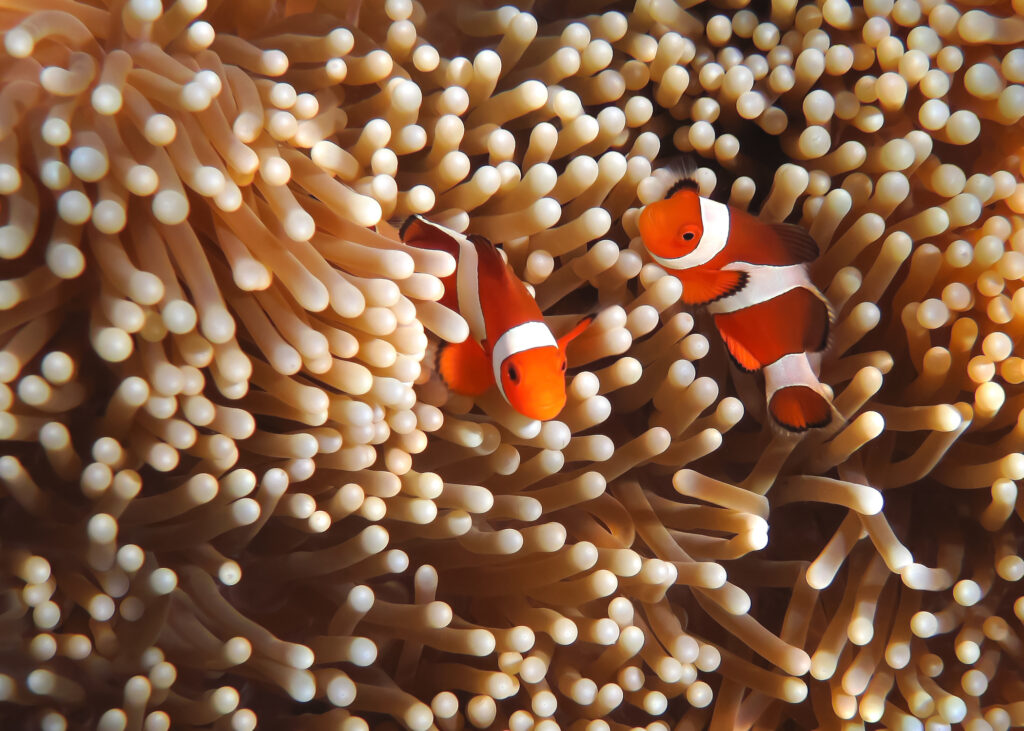Clownfish, with their vibrant colours and distinct personalities, have captured the hearts of many and are typically an aquarium favourite.
In this article, we’ll dive into the depths of clownfish knowledge, exploring their common traits, different species, habitats, diet, reproduction, and the unique relationship they share with sea anemones. Get ready for a journey beneath the waves as we uncover 5 fun facts about clownfish.
What is a clownfish?
Known scientifically as Amphiprioninae, clownfish are saltwater fish that belong to the wider family Pomacentridae which also includes damselfish. These small, brightly coloured creatures are native to warm waters, particularly found in the Red Sea and Pacific Oceans, inhabiting sheltered reefs or lagoons. Their common name is derived from their playful and clown-like appearance, characterised by vibrant colours and distinctive patterns.
Types of clownfish
While there are about 30 recognised species of clownfish, the common clownfish (Amphiprion ocellaris) takes the spotlight. These fish are relatively small, reaching lengths of 2 to 5 inches, and their eye-catching orange bodies adorned with white stripes make them easily identifiable.
Other notable species include the percula or orange clownfish (Amphiprion percula) and the tomato clownfish (Amphiprion frenatus). Each species has unique characteristics; for example, the tomato clownfish is largely an orange-red colour with just one white vertical stripe behind its eye.
Clownfish appearance
Colours
The signature appearance of clownfish includes an orange body with white stripes, a striking combination that distinguishes them from other marine species. However, not all clownfish exhibit the same colouration. Some variations can include a darker orange hue, while rare genetic mutations can result in individuals with black, yellow, or even melanistic colouring. For example, Clark’s anemonefish is also known as the yellowtail clownfish thanks to its black body, white stripes and yellow tail and fins.

Weight
On average, clownfish weigh between 42 to 70 grams. Their small size contributes to their agility and ability to navigate through the intricate structures of coral reefs. This weight range highlights the lightweight nature of these fascinating marine creatures.
Where do clownfish live?
Clownfish thrive in warm waters, specifically in the Red Sea and Pacific Oceans. They prefer sheltered reefs or lagoons as their habitat, often seeking refuge among the tentacles of sea anemones.
What do clownfish eat?
Despite their adorable appearance, clownfish are omnivores, meaning they consume both meat and plants. Their diet includes crustaceans, algae, zooplankton, and worms. This versatile palate helps them adapt to different environments within coral reefs.
Reproduction and lifespan of clownfish
Clownfish have a fascinating reproductive process and lifespan. In the wild, they generally live for about 8 years, while in captivity, they can extend their lifespan to up to 12 years. One of the most intriguing aspects of clownfish reproduction is their unique sex-changing ability.
All clownfish are born male but can change into females – this sex change is irreversible. If the female of a mating pair dies, the dominant male transforms into a female and rapidly grows in size to take on the role of the matriarch. This adaptation ensures the survival of the group and the continuation of their lineage.
Symbiotic relationship between clownfish and sea anemones

Sea anemones, which are related to corals and jellyfish, are fascinating organisms that provide a safe haven for clownfish. This symbiotic relationship, known as mutualism, benefits both species. Clownfish find protection within the stinging tentacles of sea anemones and even receive prey to eat. In return, clownfish offer food to the anemone, help rid it of harmful parasites, and protect it from potential threats like butterflyfish.
Additional clownfish facts
As we delve deeper into the underwater world of clownfish, here are some additional fun facts:
Communication: Clownfish communicate with each other through popping and clicking noises, often using these sounds to establish territory or attract a mate.
Swimming abilities: Despite their popularity, clownfish are poor swimmers, relying on their unique mode of travel known as “jet propulsion.” They use rapid movements of their pectoral fins to navigate through the water.
Female dominance: In a notable departure from traditional animal hierarchies, clownfish have the most aggressive females as leaders within their social groups. This dynamic sets them apart from many other species where males typically hold the dominant position.
Daddy day care: As seen in the film Finding Nemo, the male clownfish are usually responsible for the majority of child-rearing, with females only helping out on occasion.
Year-round hatching: Unlike many species of fish that have very specific times in which they can be hatched, clownfish can be hatched at any time of the year.
Clownfish are not just charming characters in animated movies; they are fascinating creatures with a myriad of unique traits. From their vibrant colours to their intricate symbiotic relationships with sea anemones, these fish continue to captivate marine enthusiasts worldwide.
Whether you’re a seasoned aquarium hobbyist or simply intrigued by the wonders of the ocean, booking tickets to Blue Reef Aquarium to see our clownfish offers a captivating glimpse into the beauty and complexity of marine life. So, the next time you spot these iconic fish, remember the fun facts that make them truly extraordinary.
